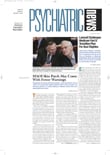Emotional or behavioral upheaval during adolescence often predicts a personality disorder later in life. So suggests a study of middle-aged subjects who had been diagnosed with emotional or disruptive behavior disorders during adolescence.
Results appeared in the October American Journal of Psychiatry.
Even though personality disorders represent a major health problem, the evidence linking them and adolescent psychiatric illness is limited. So Margareth Helgeland, Ph.D., of the Sogn Center for Child and Adolescent Psychiatry in Oslo, Norway, and coworkers conducted a study to gain more insights into the links between adolescent psychiatric illnesses and adult personality status. “To our knowledge,” they said, “this is the first long-term follow-up study of a reliably diagnosed adolescent population with adult DSM-IV personality disorders as an outcome variable.”
The study assessed 130 adult subjects with an average age of 43 who had been hospitalized during adolescence (at age 15, on average) for either an emotional disorder or a disruptive behavior disorder.
The emotional disorders included anxiety, depressive, eating, somatoform, and elimination disorders. The disruptive behavior disorders included conduct, oppositional defiant, psychoactive substance use, and attention-deficit/hyperactivity disorders, as well as adjustment disorder with disturbance of conduct.
The Structured Clinical Interview for DSM-IV Axis I Disorders and the Structured Interview for DSM-IV Personality were used to interview the subjects. Interviews were conducted in subjects' homes, at the University of Oslo, at mental health care institutions, or in prison. The average duration of each interview was five hours.
Sixty-five percent of subjects who had had an adolescent disruptive behavior disorder and 58 percent of those who had had an adolescent emotional disorder were found to have at least one personality disorder at follow-up. In other words, an emotional or behavioral disorder during adolescence often seemed to precede a personality disorder in adulthood, although in general, adolescents with disruptive behavior disorders were not significantly more likely than adolescents with emotional disorders to have adult personality disorders.
However, adolescents with disruptive behaviors were significantly more likely to have adult cluster B personality disorders—antisocial, borderline, histrionic, and narcissistic disorders—than adolescents with emotional disorders were.
For male subjects, adolescent disruptive behaviors were a significant and independent predictor of an adult antisocial personality. This was not the case for young women.
In contrast, adolescent emotional disorders were significant and independent predictors of adult cluster C personality disorders—avoidant, dependent, obsessive-compulsive, self-defeating, and passive-aggressive personality disorders—in female, but not in male, adolescents.
“Overall,” the researchers wrote, “the results of this study support the view that personality disorders can be traced back to emotional and disruptive behavior disorders in adolescence. In addition, our results clearly demonstrate that gender may play a moderating role in those continuities.”
Nonetheless, they admitted, “the pathways from adolescent disruptive and emotional disorders to adult personality disorders are influenced by complex and as yet unknown interactions among constitutional factors and extrinsic factors, such as stressors, trauma, family pathology, cultural and economic factors, and treatment.”
The study was funded by the Norwegian Foundation for Health and Rehabilitation and the Regional Center for Child and Adolescent Psychiatry, Region East and South.
Am J Psychiatry 2005 162 1941
